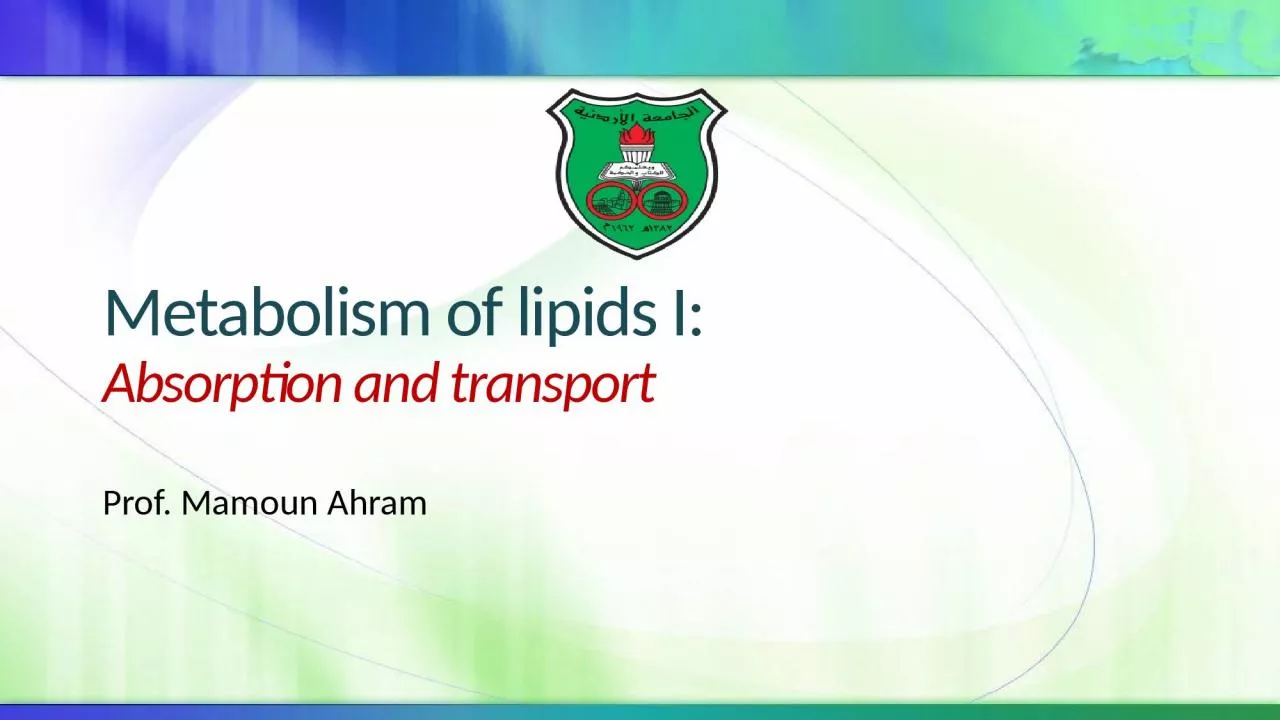

Prof Mamoun Ahram Resources This lecture Lippincotts Biochemistry Ch 15 What are lipids Lipids are heterogeneous hydrophobic compartmentalized in membranes as droplets of triacylglycerol TAG or in lipoprotein LP particles or or proteinbound ID: 1043206
Download Presentation The PPT/PDF document "Metabolism of lipids I: Absorption and t..." is the property of its rightful owner. Permission is granted to download and print the materials on this web site for personal, non-commercial use only, and to display it on your personal computer provided you do not modify the materials and that you retain all copyright notices contained in the materials. By downloading content from our website, you accept the terms of this agreement.
1. Metabolism of lipids I:Absorption and transportProf. Mamoun Ahram
2. ResourcesThis lectureLippincott’s Biochemistry, Ch. 15
3. What are lipids?Lipids are heterogeneous, hydrophobic, compartmentalized in membranes, as droplets of triacylglycerol (TAG), or in lipoprotein (LP) particles or, or protein-bound. Functions: Energy, structures, molecular precursors (e.g., vitamins, signaling)NPLDLFATAGPLCH and CESL
4. Structure and classification of lipids
5. Double bonds in FA are always spaced at three-carbon intervals. The addition of double bonds decreases the melting temperature (Tm) of a fatty acidIncreasing the chain length increases the Tm. Membrane lipids typically contain unsaturated LCFA to maintain fluidity.
6.
7. Forms of fatty acidsFree fatty acids (FFA): occur in all tissues and plasma (particularly during fasting). >90% of the plasma fatty acids are in the form of fatty acid esters (primarily TAG, cholesteryl esters, and phospholipids) contained in circulating lipoprotein particles.Plasma FFA are transported on albumin from adipose tissue to most tissues. FFA can be oxidized by many tissuesLiver and muscle, to provide energyLiver to synthesize ketone body Structural FA: membrane lipids as phospholipids and glycolipids Protein-associated FA facilitate membrane attachment. FAs are precursors of the hormone-like prostaglandins Esterified FAs: in the form of TAG stored in white adipose tissues as the major energy reserve of the body.
8. LipoproteinsFunction: transport of lipids (cholesterol, cholesterol esters, phospholipids & triacylglycerols) in blood plasma.As lipid content increases, the density decreases
9. Composition of lipoproteinsChylomicronsVLDLLDLHDLDensity (g/ml)< 0.940.94-1.0061.006-1.0631.063-1.210Diameter (Å)2000-600060025070-120Site of synthesisIntestineLiverLiverLiver, intestineTotal lipid (wt%)99928550Triacylglycerols85 55Liver106 Cholesterol esters318 50(bad)40(good)ApolipoproteinsA, C, E, B48C, B100, EB100A, C, EFunctionTransport of dietary TGTransport of liver TGTransport of cholesterol to peripheral tissuesTransport of cholesterol from peripheral tissues(cholesterol scavengers)
10. Lipid transport
11. Digestion of lipids
12. Digestion in the stomachAcid-stable lipases: lingual lipase and gastric lipaseMain target: triacylglycerides with short- and medium-chain fatty acids (≤ 12 carbons)Significance: infants and patients of pancreatic lipase-deficiency or pancreatic insufficiency (e.g., cystic fibrosis).Short- and medium-chain fatty are absorbed in stomach.
13. Emulsification in the small intestineTwo mechanisms of emulsification in the duodenum:Peristalsis : mechanical mixing leading to smaller dropletsConjugated bile saltsCholic acid
14. Degradation by pancreatic enzymesTriacylglycerol degradation
15. The significance of colipaseColipase:Secreted as a zymogen from the pancreasActivated by trypsinAnchors lipase into the micelle interface at a ratio of 1:1Restores activity of lipase against inhibitorsCombined pancreatic lipase-colipase deficiency is an orphan disease
16. Degradation by pancreatic enzymesDegradation of cholesteryl ester85-90%Bile salts
17. Degradation by pancreatic enzymesDegradation of phospholipidsBile saltsPro-PLA1TrypsinExcreted in the fecesFurther degradedAbsorbed
18. Hormonal controlEntry of food induces the release cholecystokinin (CCK; a of peptide hormone) from the duodenum and jejunum .Induces contraction of the gallbladder to release bile (bile salts, phospholipids, and free cholesterol)Acts on the exocrine pancreatic cells to release digestive enzymesDecreases gastric motility to slow down the release of gastric contentsThe low pH of the chyme entering the intestine induces intestinal cells to produce secretin (a peptide hormone).Causes the pancreas to release a bicarbonate-rich solution to neutralize the pH and make it optimal for the digestive pancreatic enzymes.Inhibits gastric motility.
19. Slows gastric motility
20.
21. Absorption by enterocytesMicelles are formed in the lumen from FFA, free cholesterol, bile salts, and fat-soluble vitamins.Cholesterol is poorly absorbed.Note: it can be drug-targetedShort- and medium-chain FF are directly absorbed.95%5%H2OH2OH2OH2ONPC1L1Niemann-Pick C1-like 1 proteinEzetimibe
22. Reformation of complex lipidsAlbuminPrincipal causes of steatorrhea: Short bowel diseaseLiver or biliary tract diseasePancreatic exocrine insufficiencyLCFAs enter SER by binding to fatty acid–binding protein 2 (FABP2)
23. Celiac disease (CD)Fat malabsorption leading to steatorrheaIt is an autoimmune response to gliadin, a peptide found in gluten (wheat, rye, and barley). Gliadin contains many proline and glutamine residues, making it resistant to digestion.Lab tests indicate the presence of anti-tissue transglutaminase (anti-tTG) antibodies.Tissue biopsy reveals the absence of villous surface epithelial cells resulting in decreased nutrient absorption.http://courses.washington.edu/pbio376/celiac/celiacdisease-376.html
24. Formation and release of chylomicronsTAG and cholesteryl esters are packaged in chylomicrons made of phospholipids, nonesterified cholesterol, and apolipoprotein B-48.Microsomal triglyceride transfer protein (MTP) is essential for the assembly of all TAG-rich apo B–containing particles in the ER.Cytidine deaminase
25. Fates of TAGs in chylomicronsTAGs in chylomicrons are hydrolyzed in the bloodstream by lipoprotein lipases that are anchored in capillary walls. The resulting fatty acids have two possible fates: When energy is in good supply, they are converted back to TAGs for storage in adipose tissue. When cells need energy, the fatty acid carbon atoms are oxidized into acetyl-CoA.Familial chylomicronemia (type I hyperlipoproteinemia) is a rare, autosomal-recessive disorder caused by a deficiency of LPL or its coenzyme apo C-II resulting in fasting chylomicronemia and severe hypertriacylglycerolemia, which can cause pancreatitis
26. Fate of glycerolGlycerol is carried in the bloodstream to the liver or kidneys, where it is phosphorylated and then converted to glyceraldehyde 3-phosphate and dihydroxyacetone phosphate (DHAP) for either glycolysis or gluconeogenesis or synthesis of TAG.
27. Fate of chylomicronsWhen TAGs are removed, chylomicrons remnants would contain cholesteryl esters, phospholipids, apolipoproteins, fat-soluble vitamins, and a small amount of TAG).Chylomicron remnants bind to apoE receptors on the liver via their apoE and are endocytosed. The intracellular remnants are hydrolyzed to their component parts. Type III hyperlipoproteinemia: mutations in apoE gene leading to decreased clearance of chylomicron remnants.